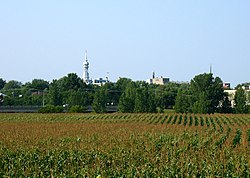Nicolet, Quebec
| Nicolet | |
|---|---|
| City | |
 |
|
 Location within Nicolet-Yamaska RCM. |
|
| Location in southern Quebec. | |
| Coordinates: 46°13′N 72°37′W / 46.217°N 72.617°WCoordinates: 46°13′N 72°37′W / 46.217°N 72.617°W | |
| Country |
|
| Province |
|
| Region | Centre-du-Québec |
| RCM | Nicolet-Yamaska |
| Constituted | December 27, 2000 |
| Government | |
| • Mayor | Geneviève Dubois |
| • Federal riding | Bécancour—Nicolet—Saurel |
| • Prov. riding | Nicolet-Bécancour |
| Area | |
| • Total | 129.20 km2 (49.88 sq mi) |
| • Land | 96.11 km2 (37.11 sq mi) |
| Population (2011) | |
| • Total | 7,828 |
| • Density | 81.5/km2 (211/sq mi) |
| • Pop 2006-2011 |
|
| • Dwellings | 3,515 |
| Time zone | EST (UTC−5) |
| • Summer (DST) | EDT (UTC−4) |
| Postal code(s) | J3T |
| Area code(s) | 819 |
| Highways |
|
| Website | www |
Nicolet, Quebec is the county seat of Nicolet-Yamaska Regional County Municipality, Quebec, Canada. The population as of the Canada 2011 Census was 7,828. It is the seat of the Roman Catholic Diocese of Nicolet.
The residents of the town pronounce the final "t" in Nicolet, however people outside of the region do not.
The town took its name from Jean Nicolet, a French explorer and clerk of the Company of One Hundred Associates, who explored the Great Lakes region west to Wisconsin. Despite never having lived there, he explored the area during the seven years he lived in Trois-Rivières. The area was originally settled by the Abenaki tribe, who knew it as Pithigan or Pithiganek, meaning "entrance". French colonial settlement of Nicolet area began in the late 17th century, with Pierre Monet de Moras constructing a seigneurial manor on what is now known as Moras Island. Rights to the territory of Nicolet was accorded in 1672 by Jean Talon, passing through several hands in the next thirty years. Significant land development began at the opening of the 18th century, with the construction of the Saint-Jean-Baptiste Jesuit mission in 1701, a chapel in 1710, a presbytery in 1722, and a second church being raised in 1740.
The first Acadian settlers arrived in 1756, after their expulsion by the British, who had defeated the French in the Seven Years' War. During the late 18th century, the area eventually became a major centre for the Acadian diaspora. Some Acadian refugees continued south into the United States.
...
Wikipedia

